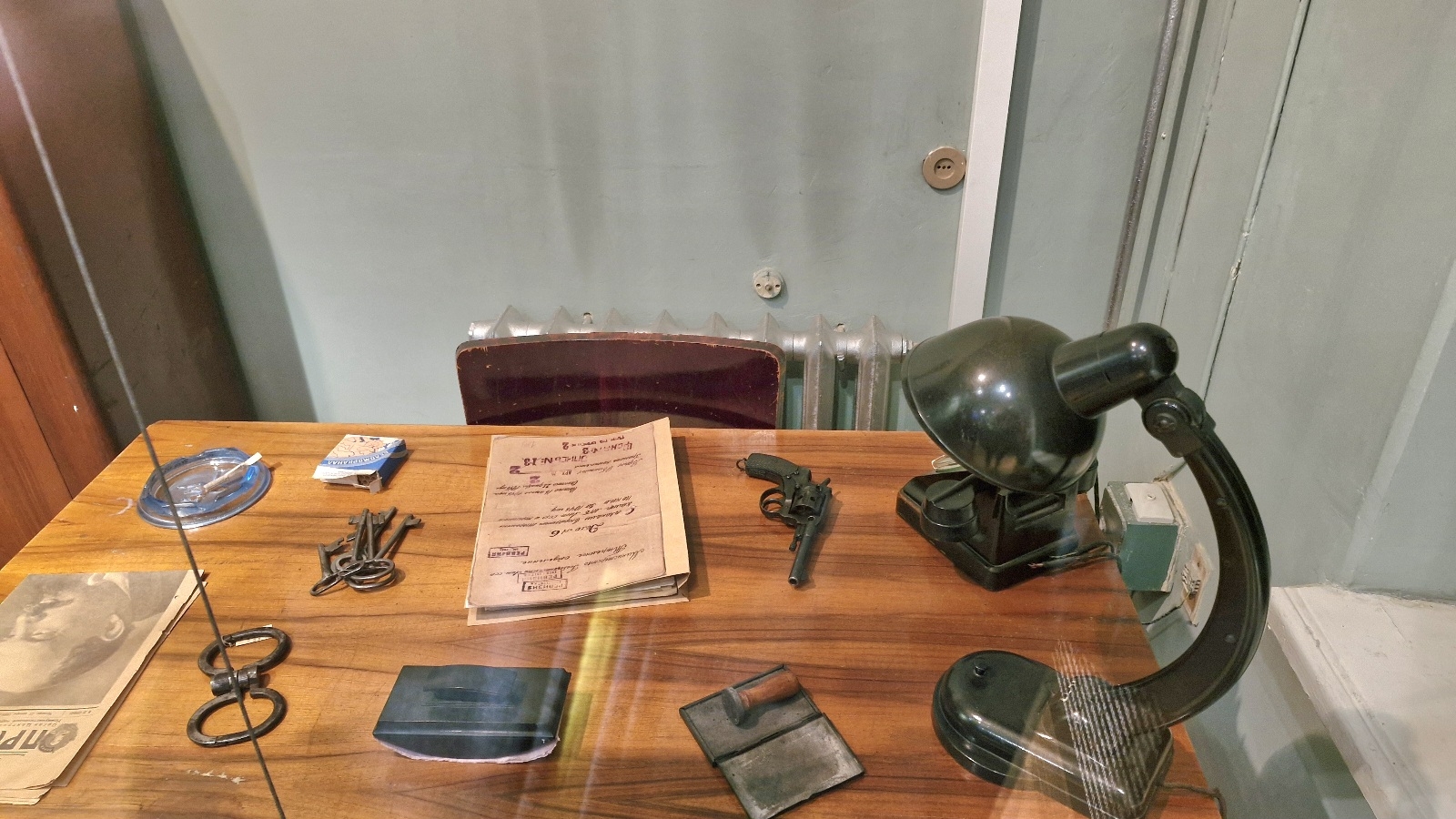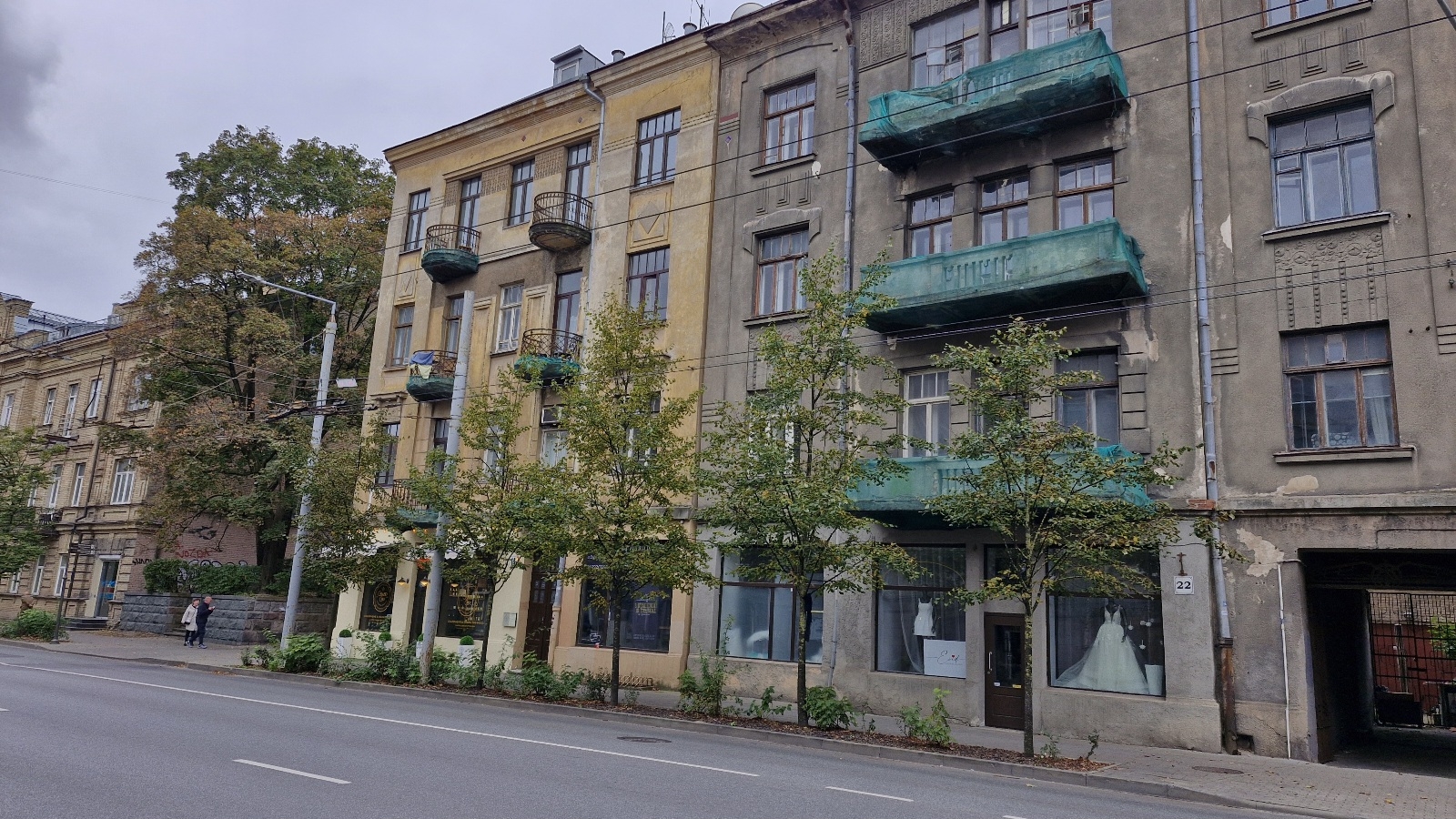34. Vilnius Part 2
Breakfast on my second day in Vilnius was a bit chaotic, as the hotel was full of tours and it seemed everyone wanted to eat at the same time.
There were some weird offerings such as big bowls of salad, porridge with cinnamon and honey already added, pasta bake, thick boiled chicken sausages, and three breakfast cereals that were nameless but looked like they contained lots of sugar. The scrambled eggs either only contained egg whites or Lithuanian hens are anaemic and mineral deficient. The only two bread choices contained cardamon seeds. At least the coffee was really good!
I had only three things on my wishlist today, the KGB Museum, the Užupis “Republic“ and a stroll around the Old Town.
The KGB Muzeum was first on my list. It is in the former KGB HQ in the city. From the outside it looks just like a rather fancy house from the early 20th century.
Inside however, in the basement and out the back, there is a warren of prison cells, torture rooms, solitary confinement cells and access to the original exercise yards. Unlike the Museum of Terror in Budapest, photography was allowed here.
This is a two-person detention cell. The museum was really busy with a mix of school tours and older people who clearly had some connection with the place, as several of them were in tears. I think I was the only foreign tourist there.
These are photos of some of the people who died in the building. Everything is fully explained in English, but the level of detail provided was overwhelming for a non-Lithuanian and many of the names were unfamiliar to me.
It could do with a simplified version of the tour specifically for visitors, as it is impossible to absorb all the facts on one visit.
It is hard to believe that ordinary people were sent here for crimes against the state such as listening to the Beatles. If convicted, they might have been sentenced to a Gulag in Siberia for 10 years.
There were many genuine original artefacts on display. The eavesdropping equipment was fascinating.
The displays were of a very high quality, this is an unexploded Molotov Cocktail held by one of the defenders of Parliament from 1991.
The place really got to me, as so much of what went on here, happened within my lifetime, in fact the centre was still in operation until 30 years ago.
Here is a soundproofed and padded torture cell constructed as late as 1973.
Here is the hole in the wall in the execution room where the rifles would appear.
This is the duty officer's room, with some of the essential tools of the trade.
Here are the enclosed exercise yards, with an excellent exhibition displayed on each wall space about current political prisoners held in Russian jails.
The display in this yard featured the late Alexi Navalny.
I spent over two hours in the museum and the time just flew.
Outside, at the memorial site to those who were disappeared, there was a very moving ceremony taking place. A very helpful local explained to me that these were a dozen or so Vilnius senior citizens who were sent to Siberia, but who survived the experience and eventually returned to Vilnius.
It was a very emotional experience, coming so unexpectedly after the KGB Museum, and I felt privileged to witness it.
I needed a long walk after that morning and headed towards the Old Town. I went inside to have a look at the city's main indoor market hall, but it was very quiet.
While there is a lot of refurbishment taking place in Vilnius, many buildings in the city are in a poor or dangerous state of repair.
Many have protective green netting stopping bits of loose concrete and masonry from falling on the heads of passers by.
Some of the footpaths are in a really poor state. I would say the harsh winter frosts play havoc with concrete.
There were of course many beautiful streets as well, filled with coffee shops, bars and restaurants.
Lithuania being a very Catholic country, it seemed as if churches and religious buildings were on every street. Here are some that caught my eye.
It was very common to see nuns in full habit in the streets. This was also the case in Poland but it is no longer something you would ever see in Ireland.
Here is the famous Gate of Dawn the most photographed building in the Old Town.
There was a religious ceremony happening in this church.
The tour guide strongly recommended visiting Sultiniai, an original nostalgic small diner which amazingly has apparently remained unchanged for at least the past 50 years. It takes you back to Soviet Lithuania, as they only serve authentic cuisine of the 70s and 80s (grandma’s cooking as she called it). I couldn't wait to try it, so I called in for a late lunch.
The formica tables and plywood panelling were straight from the 70s. Here is where I had to speak my first words in Lithuanian as the workers had no English. Lithuanian seems to sound like it is written (based on the names of all the bus and tram stops anyway) so I had a stab at it and surprise surprise I was understood, and I got my one and only Lithuanian smile of the two days!
The diner was full of locals of all ages, and not a tourist in sight. The prices were also stuck in the 70s: my main course of 'Milanese' chicken fillet with mushroom gravy, mashed potatoes and two types of coleslaw, was wonderful. Followed by coffee, the bill was only €8.60. What an experience!
I did some more strolling around after lunch and made my way towards Užupis. During my walk, I spotted several examples of traffic lights with female symbols and not the usual male ones, which I thought was interesting.
I also spotted a plaque on Iceland Street, honouring the fact that Iceland was the first country to recognise the new independent Lithuania.
The plaque was next to a pseudo Irish Bar called The Piano Man, but as it wasn't the real deal I didn't bother taking a picture.
I also noticed that on every city bus there was a sign of support for Ukraine. All Ukrainians have free transport in the city.
The Republic of Užupis
Having read about Užupis I definitely wanted to visit it. Apparently it is regarded as a Vilnius version of Christiania in Copenhagen, but on a much smaller scale.
It started as a tongue-in-cheek April Fools’ Day joke in 1997, when the district declared itself an independent republic (the Republic of Užupis), with its own constitution, but nobody really took this seriously. It has never been recognised by any country!
It has evolved into one of the smallest republics in the world, covering less than 1 sq km. It has its own president, government, constitution and currency, and even has a navy consisting of few small river boats. It did have an army once, of "around 10 men", but given the republic’s peace-loving attitude, it has been retired!
The district has been popular with artists for decades due to its bohemian and laissez-faire atmosphere.
It is dotted with street murals and installations like "The Angel of Užupis,” a large bronze angel in the main square, which is the symbol of the Republic.
On the riverbank there is a famous mermaid sculpture, and outdoor art exhibitions are held along the river embankment.
Artists’ studios line narrow streets alongside local-designer boutiques, hipster cafes, and vegan- vegetarian eateries.
The constitution of the “Republic of Užupis,” is mounted on wall plaques (above).
Having walked the best part of 10km, it was time to have a rest. There was a pub in Užupis called Spunka (!) that specialises in craft beers, that I wanted to check out, but it was closed, so I headed back to the hotel. I could not find a single bar in the city open at 4pm!
After an hour or two relaxing in my tiny room, I headed out for dinner to a place I had spotted earlier that specialised in Lithuanian regional cuisine called Etno Dvaras. I knew it would be full of tourists but it was only a short walk from the hotel.
To start I had wild mushroom soup served in a rye bread bun.
I followed this with a chicken kiev, Lithuanian style, and I tried a tasting tray of four local craft beers.
It was full of tourists and it was expensive. To be honest I didn't think it was anything special.
Final thoughts
VIlnius is a smallish capital city. There are a lot of parks and greenways, which makes it seem smaller maybe than it is.
It is a tale of two or three different cities, the UNESCO World Heritage Old Town is its jewel in the crown, but it has some areas particularly round the back of my hotel and near the stations that are quite seedy.
Then there is the new city centre with its skyscrapers and shopping malls, bordered on one side by remnants of Soviet times in a now protected quarter, and on the other by the 300 or so wooden houses, ranging from one hundred to three hundred years old.
It being based around an old medieval settlement gives Vilnius a confusing layout with many curving streets. I found it difficult to get my bearings a few times. I realise now that I prefer planned cities with a grid layout.
It has a certain charm, but it wasn't one of my favourite cities on this trip.




















Comments
Post a Comment